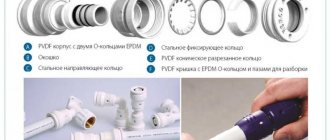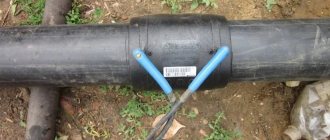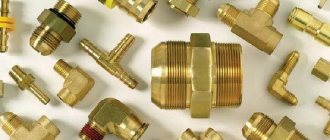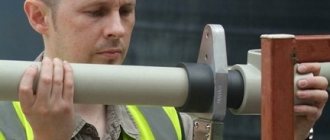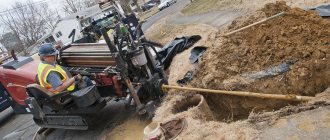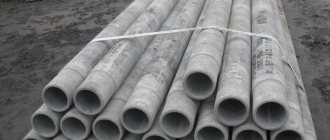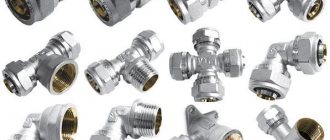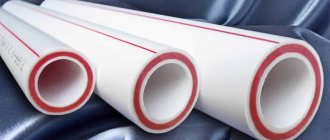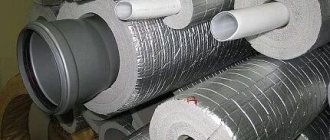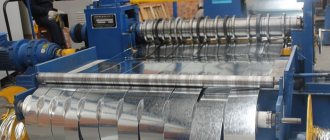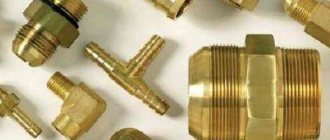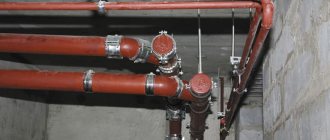Pipe rolling is a necessary part of the process of partially changing the shape of pipes, due to which hollow metal products are given the required configuration or the diameter is expanded. Pipes can be rolled in different directions, depending on the intended result. The process of changing the diameter is carried out on machines in the workshop or at home - using simple devices. Using the rolling method, it is also possible to form products from sheet metal.
To change the original shape of the pipe, a rolling operation is used
Features of the rolling process
Rolling is an affordable process for manufacturing all kinds of metal parts or pipe sections of the required format. Each tube flaring tool has its own specifics, but this process is also used for other purposes - processing a metal rod or thin sheet metal.
The name of the process comes from a primitive device - special rollers are quite simple in design and operation, but they provide a wide rounding radius for the workpieces. Industrial production involves the use of forging rollers (rolls) through which a piece of metal passes.
Correct use of the tool guarantees high-quality and uniform deformation along a given circle or at a certain angle. For example, you can get a blank of the correct cylindrical shape or a curl for a forged gate using rollers for a profile pipe with your own hands.
Rollers are selected according to the thickness of the metal product; rollers with a large radius are often required. Not only steel becomes ductile when processed with the above devices. Plastics, polymeric materials and some rods, sheets and metals are deformed in a similar way:
- aluminum;
- black metal;
- soft alloys;
- galvanization.
Rolling is also called rolling a pipe on a special machine in order to obtain a bent workpiece
Attention! Today, pipe bending and rolling is a common service, but you can master this process yourself if you have an easy-to-use device. Such skills are applicable in various folk fields and industrial production, in the manufacture of welded structures - stairs, gates, furniture.
The most common methods of forming metal products after rolling a profile pipe:
- stretching;
- bending;
- winding;
- flaring of holes.
The process involves securing the pipe into the lumen using expansion, and the diameter of the pipe must be smaller than the opening. To ensure reliable connection, rolling equipment is used. But this concept implies different processes:
- Rolling as a method of changing the width of the inlet hole, lumen or diameter of the pipe during heat treatment and welding.
- Rolling of pipe bends.
- Rolling as a method of reducing diameter.
- Rolling a section of seamless pipeline.
- Flaring the workpiece to change the diameter of the pipe (increase).
Attention! Without experience, pipe rolling is not an easy task, and with excessive force, the metal will lose its ductility and may crack, and other signs of destruction will appear.
This is interesting: Chrome plating - decorative coating of metal with chromium: technology, types
Implementation
If you need to flare a copper pipe with your own hands, you will need a special tool. This also applies to products made from other materials, such as brass or aluminum.
Copper is ductile. Therefore, a physically strong person can simply pull such a tube onto a conical blank. Sometimes this is done. But you should understand that this is not the best processing method. Such a connection will not last long; the product will quickly fail, sometimes without the possibility of repair. In addition, the thin tube is quite easy to jam. There is still a risk of it breaking at the point of force.
There is a more advanced way to increase the diameter of a pipe at home, one step below rolling. To implement it, a so-called expander is required. This is a machine with a replaceable head and a lever, the use of which allows you to stretch the tube to the required shape in one action. It also wouldn’t hurt you to know how to bend a copper tube at home without special devices and equipment.
Ease of use is the main advantage of the expander. But its use does not have the best effect on the quality of work. After all, after processing, the thin walls of the pipes will expand even more, while the thick ones will not undergo changes.
Cost of services
| Sheet thickness | D=500 rub. VAT included | D=1000 rub. VAT included | D=1500 rub. with ND | D=2000 rub. VAT included | D=2500 rub. VAT included | D=3000 rub. VAT included |
| 4 mm | 3 325,00 | 5 500,00 | 8 200,00 | 10 450,00 | 13 437,50 | 15 850,00 |
| 5 mm | 3 914,00 | 6 640,00 | 10 024,00 | 13 844,00 | 15 274,00 | 20 612,00 |
| 6 mm | 3 903,00 | 8 780,00 | 12 816,00 | 15 238,00 | 19 110,50 | 24 308,00 |
| 8 mm | 6 650,00 | 11 000,00 | 16 432,00 | 30 900,00 | 25 844,50 | 33 766,00 |
| 10 mm | 6 828,00 | 12 280,00 | 20 048,00 | 25 688,00 | 30 548,00 | 39 224,00 |
| 12 mm | 8 006,00 | 13 560,00 | 21 664,00 | 28 476,00 | 34 251,50 | 44 682,00 |
| 14 mm | 9 153,00 | 15 780,00 | 25 280,00 | 33 138,00 | 39 955,00 | 52 140,00 |
| 16 mm | 10 331,00 | 18 060,00 | 28 896,00 | 37 926,00 | 45 658,50 | 59 598,00 |
| 20 mm | 13 656,00 | 22 560,00 | 36 160,00 | 47 376,00 | 57 096,00 | 74 580,00 |
| 25 mm | 15 601,00 | 28 260,00 | 45 184,00 | 59 346,00 | 71 370,00 | 93 192,00 |
| 30 mm | 18 515,00 | 33 900,00 | 54 208,00 | 71 190,00 | 85 644,00 | 111 804,00 |
| 35 mm | 25 343,00 | 45 120,00 | 72 288,00 | 94 752,00 | 114 192,00 | 149 094,00 |
Pipe rolling tool.
Rice . 3 . Lid rolling (self-feeding):
1 - spindle (rod); 2 - cover; 3— rollers.
Self-feeding rollers are sometimes incorrectly called impact rollers. Self-feeding rollers have some skew of the windows for the rollers (skew in relation to the body).
A hand-rolled cone is rotated by a regular crank placed on the square of the cone head.
The main features of various types of rolling bodies are the presence of a thrust plane or a special thrust ring, as well as the method of making windows for the rollers and their bracing.
The purpose of the thrust plane is to make it possible to correctly install the rolling (screw rolling) or to limit the translational movement of the rolling body during the rolling process (self-feeding rolling).
Rolling bodies are made with a cover (Fig. 3.) which is a stop with a movable installation thrust ring.
If we compare some designs of rolling machines, it can be noted that the thrust plane will work correctly only if it receives the necessary stop in the tube sheet. It is important to note that all protruding ends of the rolled pipe must be cut to the same height.
Pipe rolling video.
Currently, automatic rolling using a machine is used. This method significantly reduces rolling time and labor intensity, and as a result, productivity increases. Rolling using a machine drive has the following advantages:
a) the rate of pipe expansion per revolution of the rolling body is not limited by any limits;
b) the end of the flaring is determined automatically by the flaring limiter, based on the magnitude of the force on the flaring cone;
c) the rolling process proceeds evenly and smoothly.
You can see an example of such rolling in the video below.
Pipe flaring kit
The choice of tools for making more copper products is very wide. It may include the following combinations: • Mechanical flaring machine.
• Electric flaring machine.
• Set for rolling copper tubes, which also has expanders, pipe cutters and wrenches for work.
It is better to buy such a set when you are going to constantly perform such installation work, for example, for your own income. And if you only need to perform expansion once, then the simplest set for universal work, which contains a regular flaring machine, is also suitable.
Flaring stages
To obtain a reliable connection for a pipeline made of copper tubes, it is necessary to correctly roll the structure. And if you decide to flare the pipes yourself, then you need to follow these steps to do everything correctly: 1. First you need to clean the end of the pipe. 2. Then you put a specially selected coupling on the stripped part. 3. The pipe must be inserted into the flaring machine, then rotate it until a small edge of forty-five degrees is obtained. 4. Then carefully remove the completed product. 5. And use a coupling to secure two sections of the ends of the pipe. Of course, not only such fittings can be connecting parts. With the help of a professional flaring machine, you can prepare pipes for soldering fastening. The methods are basically similar. They involve deliberate deformation of the pipe to a certain size.
Features of pipe flaring
Flaring of honey tubes may be required in the following situations:
- The ends of the tubes, which are made of copper, must be prepared for their connection by soldering.
- The end of the tube must be prepared to connect it to other materials using a coupling. In such situations, when flaring, the following geometric parameters of the tube are adjusted: bending angle, internal and external diameter, and others.
- The end of the tube that was cut must be given the desired configuration.
For high-quality flaring, specially made devices and tools are used, and the following actions are performed:
- The end of the product whose connection needs to be made is well cleaned.
- A special coupling is put on the stripped end.
- Using a special device or tool, the end of the product is flared until the expansion angle is 45 degrees.
- After the procedure is completed, the end of the product is removed from the device. After this, you are allowed to start connecting immediately.
If you have never performed such a technological operation before, and are going to flare the product for the first time, then you need to cut off the tube with a margin of 2.5 centimeters. This way, if it fails, you can cut off the defective end and flare again.
If a copper tube needs to be flared in order to connect it using soldering, then the sequence of your actions should be as follows:
- Carefully clean the end of the product that needs to be flared (it is best to use specially designed brushes for this purpose).
- Using a specially designed device, the end of a tube made of copper is expanded to such a size that the end of a second tube can be inserted into it. But between the connecting elements a gap of 0.124 millimeters must be maintained. For these purposes, a measuring device is used.
- Flux is applied in an even layer to the inside of the flared section of the pipe. It is necessary to ensure a tight and reliable connection.
- The second connection element is inserted into the flared product to a depth equal to the diameter of the tube.
- Using a blowtorch, electric soldering iron or gas torch, you need to heat the future connection until the solder begins to melt.
- All gaps between the edges of the connecting copper pipes are filled with molten solder. As a result, a tight and reliable connection is formed.
After the moment when the connection of two copper tubes is formed, it is necessary to place them on a horizontal surface and wait for complete cooling.
Specific terminology of different rolling methods
The concept of “pipe rolling” is a bit of a misnomer from a linguistic point of view. This term implies two opposite operations, and parts of the deformation of the workpieces are performed without rollers.
Summarizing the terminology, it is worth mentioning that rolling is:
- changing the shape of the pipe (turning into a round, square, oval shape);
- bending at an angle or along a radius;
- molding a round or flat blank into a tube-shaped product;
- end expansion or enlargement of one end of the pipe in order to prepare for joining with a part or fragment of the pipeline;
- crimping the end of the pipe end to create a hermetically sealed joint (reducing the diameter);
- cutting metal to give the end of the pipe a different shape and diameter.
Privaltsovka. The expansion process begins after the pipe is inserted into the forming hole. This eliminates the gap between the edges of the hole and the pipe bender. Next, you need to apply force to start the deformation process with a tighter joint.
Hand tools are used to flare soft metal pipes
Flaring of steel pipes is the most common method of deforming pipelines and other products. This is a method of expanding the diameter of one of the pipeline fragments - for high-quality articulation of the sections. After such processing, the communication sections are joined using a telescopic method - the end of one pipe fits as tightly as possible into the next fragment.
Flaring of copper pipes is often used when installing water pipes and air conditioning systems. This operation (as for all other metal pipes) is performed with the following equipment:
- clamp (expander);
- ratchet (adjusts pressing force);
- cone or funnel (changes the diameter to a larger value).
Attention! Cone-shaped equipment is used for malleable and ductile metals.
Rolling is the reverse process of flaring, reducing the inlet opening of the pipeline. Often, simple devices such as a vice and a hammer are used to narrow the diameter. Also, the edges can be given a different shape - like profiled pipes. This method also eliminates defects on the edges of the tubes that occurred during cutting.
This is interesting: Shewing - processing of gears: equipment, nuances of the process
How is rolling done?
Now a little about how to flare a tube at home. The principle of operation of a pipe bender - a tool without which it is almost impossible to install plumbing equipment - is a special case of rolling. The machine roller bends the desired shape, rolling the workpiece around the base.
Rolling is required in the following cases:
- The blank of the required shape cannot be made;
- Precise adjustment of the size or angle of the product is required.
Read also: What is the difference between steel and iron?
The last option includes rolling copper pipes for subsequent installation of water supply.
Why and where is it used?
The core industry that uses the rolling process can safely be called the metalworking industry. Next on the list are all areas in which pipes and pipe connections are used. Rolling is used both to create air conditioner tubes, corrugated stainless steel pipes or heat exchanger tubes, and for very complex structures (such as a steam boiler drum).
With the help of rolling, it is possible to adjust pipelines in place for non-standard solutions. Thus, it is possible to avoid difficulties in creating new highly specialized products.
Rolling is used not only in industry, but also in everyday life. This procedure is relevant in the following cases:
- connection of air conditioner units during installation;
- laying gas and plumbing pipes;
- when soldering copper tubes of refrigeration units;
- Replacement of car brake system pipes.
Situations that may require flaring
Today there is a very large assortment of copper tubes and connecting elements. It is because of this that choosing the necessary fitting or profile will not be difficult. But despite this, there are times when flaring parts at home cannot be avoided. Flaring may be required in the following cases:
- The product must be adjusted to a certain exact size.
- The required fittings are not available for purchase at this time.
- Products of the required shape are not manufactured.
Features of rolling at home
In everyday life, rolling of products made of copper, aluminum, galvanized and stainless steel is performed on universal bending rollers that can replace machines, pipe benders and special equipment. The quality of work depends on the thickness of the walls and the suitability of the equipment for the task.
A high-quality rolling tool is quite reliable, does not require repairs, and has been used for many years. For work in home mini-shops, compact machines of the RT, R, T, SR, 5R and ST groups (mentioned above) are used. Rolling a profile pipe is more difficult to do than transforming a rounded workpiece.
Advice! Many products are easier to bend at home after heating with a blowtorch - for greater plasticity.
When rolling copper or aluminum pipes with your own hands, it is important not to rush and monitor the deformation process. With excessive pressure, the hole may expand more than required, and it is very problematic to “seal” it back. Breaks are most likely on copper and steel pipes, so all stages must be done according to technology.
Devices for work
To flare tubes made of copper with your own hands, use special devices. They can be of two types:
- With manual drive.
- Electrically driven.
They are used for installation of heating, water supply and air conditioning systems. Electrically driven tools most often combine several functions: you can not only flare a copper tube with their help, but also bend it at the angle you need.
Every tube flaring tool operates based on the principle of plastic deformation .
It is for this reason that it is important that it can handle such processes very carefully and not disturb the smoothness of the inner surface of the walls and the uniformity of the material structure, as well as maintain a uniform wall thickness.
For high-quality flaring of copper tubes, you can use the devices listed below.
Manual template
This device has a cone shape and is made of an alloy that is harder than copper. The advantages of such a device include ease of use and low price. But when using it, the walls of the copper product may rupture. This means that high quality flaring is out of the question.
Mechanical flaring machine
The main working body of this device is a roller, which consists of a hard alloy. Rolling along the edge of the copper product, the roller gives it the required configuration. When working with a mechanical flaring machine, you can make a uniform deformation of the section of the tube that is being processed, and at its end, form walls with the same thickness and high quality of their internal part.
Flaring machine with electric drive
This tool has a set of attachments that vary depending on the required wall thickness. The electric flaring machine allows you to process copper tubes with less labor and greater productivity. The disadvantages of such a device include its high price. The battery can last approximately 100 operations.
Expander
This device is manual. It allows you to flare the end of a copper product in one movement, working on the principle of a lever mechanism. Despite the fact that the design of the tool is quite simple, there are certain disadvantages. One of them, and perhaps the most significant, is the fact that it is impossible to control the wall thickness of the product to be processed. Based on this, we can conclude that there is no need to talk about a qualitative result.
Read also: Switch designation on the GOST diagram
Profile products
Profile products are manufactured in the following sequence:
- Strips are flat-shaped steel blanks, cut into narrow strips.
- The strips are butt welded to form an endless strip, which is wound on top of the drum.
- When the tape is needed, it is run onto the machine and rolled into round blanks.
- The edge is cooked, in most cases using induction current.
- The rolling machine gives the desired shape. Mechanical rollers can make any shape, even the profile of a person if desired.
Rolling of round pipes is also possible. Such processes are cheap and easy to perform.
Advice: if the product has undergone cold deformation, after finishing the work it should be thoroughly heated and allowed to cool on its own. This way you will relieve the tension that has arisen in the middle of the product.
If you use a homemade profile pipe when building a water supply system, then it is better not to overdo it when heating. Take an ordinary soldering lamp or transformer welding.
Technology
Like any other technological operation, rolling has its own GOSTs and OSTs that regulate and regulate the process and its parameters, for example: tightness control, calibration, tolerances on pipe wall thickness. Enterprises also have their own service stations for these purposes. Let us present a short list of these documents.
- GOST 13954-74 (reissued in January 1988 with Amendments No. 1, 2). Pipe ends flared for connecting pipelines along an outer cone. Design and dimensions.
- GOST R 55601-2013. Heat exchangers and air cooling units. Fastening pipes in tube sheets.
- GOST 28941.12-91 . Pipeline connections with pipe flaring. The ends of the pipes are flared.
- OST 26-02-1015-85. Industry standard. Fastening pipes in tube sheets. Ministry of Chemical and Petroleum Engineering.
- STO 002203680014-2009 . Fastening of pipes in tube sheets of shell-and-tube heat exchangers and air coolers.
It is worth noting that service stations are rarely publicly available and relate only to one enterprise. It is also worth considering the properties of the material from which the pipe is made, since the permissible forces during rolling depend on them.
Methods
Depending on the temperature of the workpiece, the pipe rolling process can be divided into two large groups.
- Hot rolling. Used when working with materials that have high resistance to deformation. For example, heating is used when rolling plastic pipes along a radius.
- Cold rolling . Suitable for soft materials such as copper, aluminum, low-quality steel and the like.
Both types of processing are used in both manual and industrial pipe rolling methods. For independent work, you will need to purchase an expander or a special set, which includes the following items: a pipe cutter, stamps with holes of various diameters, a clamp and the pipe expander itself. It is equipped with a conical expander. If the cone is black and untreated, then the set is intended for plumbing pipes, otherwise the set can be used when working with air conditioners.
When flaring, there are three main types of funnel.
- An ordinary funnel. The simplest option, found everywhere.
- European standard mushroom. This type is often found on European-made cars. Externally it resembles a car tire.
- Funnel with double folded edge. Funnels of this type are common in American-made cars.
Often, to expand the pipe on your own, a conical blank with the required angle is used. But with this approach, there is a high probability that the pipe material will deform unevenly, and perhaps the pipe will rupture or bend.
In industry, the list of equipment and tools used is much wider, so let’s look at it in more detail.
Tools and equipment
In production, the rolling process is performed not only with the help of conventional or pneumatic hand tools - a lathe, a roll bender or a rolling machine is also used for this. The use of such specialized machines and tools is determined by the size of the workpieces and the materials from which they are made.
It is the properties and parameters of the workpiece material that determine which category of tool will be used during processing.
- Category T – used for processing tubes with an internal diameter from 5.6 to 12.5 mm. Rolling depth is limited.
- Category ST - used for rolling welded products with an internal diameter of 6-11 mm. Just like the T instruments, the ST has a limited depth of use.
- Category P - intended for products with a diameter of 1.2 to 4 cm. The maximum flaring value is 4.87 cm.
- Category RT - used for species with an internal diameter of 0.55-1.29 mm.
- Category CP – used for thick tube sheets, flaring depth is 3.23 cm.
- Category 5P - intended for stainless steel tubes with thin walls.
- Category K and KO – suitable for flaring boiler pipes.
In turn, rolling mills for the production of seamless pipes also have their own division.
- Continuous extension . Designed for the production of products with a diameter of up to 110 mm.
- Short guides . Used in the manufacture of products with a diameter from 60 to 450 mm.
- Three-roll. They are used to create thick-walled pipes with a cross-section from 35 to 200 mm.
- Pilgrims . Designed to produce seamless products with a diameter of 400 to 700 mm.
Roller pipe benders are a system consisting of several rolls, their number varies from 2 to 3 (less often 4) pieces. Two rotating lower rolls in such a system press the workpiece against a third, thrust roll, around which the product is bent. As a result of such rolling, the profile of the internal section of the pipe changes. The radius of the resulting product is adjusted by selecting the diameter of the rolls and the distance between the lower elements . During processing, the machine rolls must withstand high mechanical loads, so they are made of high-strength steel alloys.
Such pipe benders are quite versatile equipment and allow you to roll angles. Also, using rollers of various types, profile pipes are created. The most popular profile pipes are square (rectangular) and oval sections.
To summarize, it is worth noting once again that the term “rolling” includes a fairly extensive list of technological processes. To obtain the desired result, it is necessary to correctly select the appropriate tool, equipment and comply with the conditions of the technological process.
Rolling K-45-47 and KO-45-47 is presented below.
Types of connection of elements
Today, two methods of connecting copper pipes are used: couplings and soldering. The method you choose during the process will completely influence the course of your actions.
When connecting products with couplings, you must adhere to the following procedure:
- You need to thoroughly clean the edges of the pipe.
- A coupling must be placed on the end of the tube.
- After this, the flaring machine must be put into operation. You need to insert the prepared pipe into it and turn the equipment screw until the bending angle reaches 45 degrees.
- After this, the processed product should be taken out of the flaring machine and connected to another element using a coupling.
Experts recommend that beginners and inexperienced home craftsmen use a coupling pipe connection after flaring.
When connecting pipes by soldering, follow these steps:
- Using a special brush, thoroughly clean the edges of the pipe.
- Insert the pipe into the flaring machine, and widen its edges so that you can insert a second pipe into it. In this case, there should be a small gap between the tubes.
- Apply flux to the pipe that is placed inside and insert it into the flared mating pipe. The insertion depth should be equal to the diameter of the tube.
- Heat the junction of two pipes using a gas torch or soldering iron. The solder should melt well and completely remove the gap between the surfaces of the tubes.
- Place the soldered elements on a horizontal surface and wait until they cool down to air temperature. Only after cooling can you work with the soldered pipe.
When choosing a flaring device, consider the diameter of the products you plan to work with. For heating systems, the cross-section range ranges from 32-40 millimeters. And for air conditioning systems, products are used whose diameter does not exceed 16 millimeters. You also need to rely on such criteria as the quality of the resulting socket and the possibility of using replaceable nozzles for different pipe sections.
The article will discuss rolling for copper pipes, its purpose and technological process.
First, it’s worth figuring out what we’re talking about. Rolling is a common change in the shape of a material. On an industrial scale, the task is accomplished using special high-strength shafts. They are rolled several times over the workpiece until the desired profile is obtained.
Rolling tools
Rolling of pipes and sheet blanks is not only different, but is also performed on different equipment. Most often, sheet bending or forging rollers are used - sheet metal is rolled between the rollers for uniform processing and obtaining a cylinder-shaped piece. It is impractical to undertake such a process manually - it requires a lot of time and experience, even if it is just rollers for a pipe bender. It is easier to deform products using a machine method, so it makes sense to contact a workshop if you do not have the skills or your own equipment, and alloy steel is difficult to work with.
Rolling of pipes from steel sheet blanks is carried out using special equipment, manual or automatic.
Rolling sheet metal between rollers produces a bend of a certain shape. Rollers and machine tools have a limit on the thickness and radius of the metal they conduct. An increase in the radius results in a decrease in the bending radius when forming a thin metal sheet on bending rollers.
Special machines are also used for flaring pipes and rolled steel. The universal tool is easy to use and allows you to mold products of the required shape. Rolling of sheet blanks is carried out through the circumference of the upper roller, but it can also make the opposite movement. After processing sheet steel with rollers, the length of the product increases slightly, and the cross-section becomes slightly smaller, due to thermal and mechanical treatment.
The most popular rolling tool:
- P series machine (products with a diameter of up to 40 mm);
- RT equipment (products with a diameter of up to 5.50-11.5 mm);
- T series equipment (products with a diameter in the range of 6-11mm);
- ST rollers (products with a diameter of 6-11mm);
- CP series equipment (parts of thick tube sheets);
- 5P series tool (thin-walled products).
Often, to change the bend of a pipe, a household pipe bender controlled by a handle is sufficient. In this case, the radial shape of the product is formed by means of a regulating roller during rolling.
Important! To prevent the pipe from flattening at the point of its bend, you need to pour sand into it before deforming it in order to preserve the natural shape of the walls as much as possible.
The three-roller pipe bender is also suitable for rolling metal products. Its purpose is to work with stainless steel products of rectangular and square shape. This tool bends such workpieces well into an arc. The pipe bender processes the product from both sides.
A three-roll pipe bender can easily process profile pipes - square or rectangular
Flaring of tubes with hand tools is carried out on aluminum and copper, since these are the softest metals. The limiting factor for industrial equipment is the power and wall thickness for which a particular device is designed.
Advice! You should not use thin-walled pipes for water supply in a private home. The result is simple flaring and joining, but it will not last long due to metal corrosion.
Tips for choosing a tool
It is not difficult to flare a copper tube, given the high degree of ductility of such a material. But to obtain a good and high-quality result when performing such a technological procedure, you need to choose only specialized devices and tools. If you use the simplest devices, which include expanders and blanks, the result can be negative:
- If the walls of the product are small in thickness, they will bend.
- When such a tool impacts the walls of the product, ruptures may occur.
- It is almost impossible to achieve uniform wall thickness. As a result, this result will affect the reliability of the connection.
The advantages of using specialized tools are the following factors:
- After flaring, the inner surface of the product becomes perfectly flat and smooth.
- Even if at the beginning of the process there was no uniform thickness of the walls of the product, then during the flaring process this parameter will be achieved.
- Ruptures of the tube walls due to gradual deformation are practically excluded.
In addition, the use of special equipment will allow the end of the product to be flared efficiently and quickly, even for a person who has not previously carried out such a procedure with his own hands.
The flaring kit may include the following tools:
- Springs for bending pipes.
- Pipe expander.
- Pipe cutter
- Riemer.
- Eccentric rolling.
For better flaring, special attention must be paid to the choice of tools. It is necessary to rely on such parameters as:
- The presence of connecting seams on the surface of the workpiece.
- The need to form grooves on the part of the pipe that is to be processed.
- The wall thickness of the product to be processed.
- The length between the centers of the internal holes in the copper tube (if the device you have chosen for flaring allows you to process several products at the same time).
- The distance the tube will protrude above the work surface.
- Flaring depth.
- Internal and external diameter of the product.
- Characteristics of the material from which the tube was made. Particular attention is paid to the degree of its plasticity.
Almost all tools that are specifically designed for flaring copper tubes that are on sale today are versatile. With their help, copper tubes can be processed in a fairly wide range of their outer and inner diameters. This tool comes with interchangeable attachments that provide a wide range of applications.
